Historische Edelsteinminen im Steinkaulenberg
Historic Gemstone Mines in the Steinkaulenberg
Useful Information
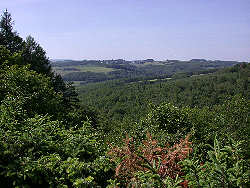
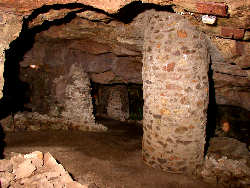
| Location: |
From Idar follow road to Algenrodt, turn right at the Straßburgkaserne.
1,2 km to the parking, signposted.
(49.7247644, 7.2751810) |
| Open: | 15-MAR to 15-NOV daily 9-17. [2006] |
| Fee: |
Adults EUR 4, Children EUR 2.50, KChildren (0.5) free, Disabled EUR 2.50, Students EUR 2.50, Wherpflichtige EUR 2.50, Zivildienstleistende EUR 2.50, Unemployed EUR 2.50. Groups (10+): Adults EUR 3, Pupils EUR 2, Children (0-5) EUR 1. [2006] |
| Classification: |
 Quartz Mine
Agate mine Quartz Mine
Agate mine
|
| Light: |
 LED LED
|
| Dimension: | 37 different tunnels, together L=750 m, D=60 m. A=430-470 m asl |
| Guided tours: | |
| Photography: | allowed |
| Accessibility: | yes |
| Bibliography: |
Hermann Bank (1991):
Das Schaubergwerk Steinkaulenberg in Idar-Oberstein,
Förderverein Steinkaulenberg e.V. Idar-Oberstein, Charivari-Verlag, 1991.

|
| Address: | Historische Edelsteinminen im Steinkaulenberg, Idar-Oberstein, Tel: +49-6781-47400. |
| As far as we know this information was accurate when it was published (see years in brackets), but may have changed since then. Please check rates and details directly with the companies in question if you need more recent info. |
|
History
| 1841 | Galgenberg area renamed Steinkaulenberg. |
| 1847 | Steinkaulenberg was the most famous source of Agates in Europe. |
| 187? | end of the mining in the Steinkaulenberg area. First attempts to make them accessible to visitors by cleaning and improvement of some tunnels. |
| 1959 | survey of all mines and tunnels in the area by the Rohsteinhändlerverband (= society of the rock traders). |
| 1964 | first tunnels opened to the public by a club called Aufbaugemeinschaft, led by Eugen Morschhäuser. |
| 1978 | foundation of the Förderverein Steinkaulenberg. |
Geology
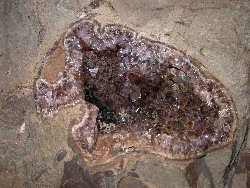
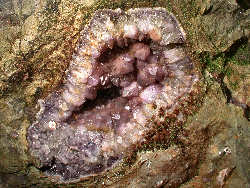
During a volcanic phase some 140 million years ago, a big area between Freien and Fischbach was covered by Lava. There was both a surface lava flow producing basaltic layers and the intrusion of magma into dykes. The dykes were cooling very slow, insulated by the covering rocks. The heat was transported by the convevtion of groundwater. This thermal water dissolved silicates from the rock and redeposited them in hollows.
The dissolving of silicated depends on the EH and pH value of the water, which may change in the groundwater from one point to the other. That’s the reason why water is able to dissolve minerals at one location while it redeposits them on another. The basaltic lava had numerous huge gas bubbles, which became holes in the rock when the lava cooled dow. During the thermal phase those bubbles were filled by silicates, in the common form called agate. It they were not completely filled, the rest of the hole was full of groundwater and the silicates very slowly despositing from this water formed crsytals. This kind of mineral filled hollow is called a geode. In the soft basaltic layer, there are hard eggs of agate, which are hollow with crystals inside.
The common minerals found in the Idar-Oberstein area are agates, rock crystals, amethysts, and smoke quartz. The famous specialty found only once in the world at the Steinkaulenberg is green jaspis.
Description
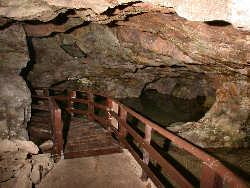
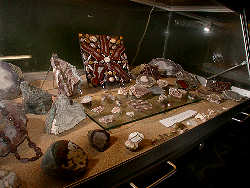
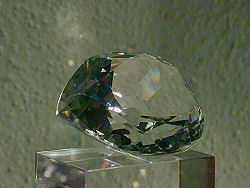
The Steinkaulenberg, a hill above the village Oberstein possesses a nice view and an extraordinary deposit of semi-precious quartz minerals. This mine was the base of the famous jewelry industry of Idar-Oberstein. At this tme the people looked for the so-called Mandeln (almonds), how they called the geodes which are completely filled by agate. The ones with crystals inside were not useful for the production of jewelry and were thrown on the waste heaps. Today mineral collectors from all over the world roam the old waste heaps for those crystals. But this may be dangerous, as the remains of mining activities are often unstable.
The mine at the Steinkaulenberg was operated until 1870. At this time the mining was extremely labor-intensive and the agate was expensive. At this time many germans emgirated to North and South America. Emigrants form this area, which came to Minas Gerais in Brasilia, immediately discovered the wealth of huge geodes, whcih were found in clay and hence very easy to mine. They started mining and sold the agate back to their old homeland. The new agate was not only cheaper, but also bigger, harder, and even more beautiful. This ended the mining at the Steinkaulenberg.
The mine is actually one big chamber, with some short side passages and niches. There are for lakes, filled by dripping water. geodes, with minerals ad completely filed, can be seen in abundance at the walls. At one point there is a formation of the green jaspis. The trails through this chamber have no steps, so they are accessible with wheelchairs or buggies.
The town Idar-Oberstein has numerous sights conected with the gemstone and jewelry industry. First there is the historic Weiherschleife, a grind where agate was processed into jewelry at water driven weels. Once there were 56 grinds along the river. This ine is open to the public, there are grinding demonstrations, a mineral museum and a multimedia show.
The most outstanding sight is the Edelsteinmuseum (jewel museum) in Idar. It shows a collection of extraordinary jewels which are loaned from the big jewel dealers of the town. These are extraordinary minerals, semi-precious and precious gems. There are replicas of the most faous diamonds, journeyman’s pieces, and all kinds of commodities made of agate.
Probably the most ordinary exhibit of the museum is a cube made of agate, which has a hole in the middle of one side. If you have a close look, you can see a sphere of agate inside the agate cube. It is possible to move the sphere freely inside the cube. The gap between the sphere and the spherical hole in the cube is 1.5 mm. The artist who created this object keeps the way he did it a secret, and this is the only existing exemplar.
- See also
 Search DuckDuckGo for "Steinkaulenberg"
Search DuckDuckGo for "Steinkaulenberg" Google Earth Placemark
Google Earth Placemark OpenStreetMap
OpenStreetMap The Edelsteinminen Steinkaulenberg & Historische Weiherschleife in Idar-Oberstein (visited: 29-MAR-2011), official website.
The Edelsteinminen Steinkaulenberg & Historische Weiherschleife in Idar-Oberstein (visited: 29-MAR-2011), official website. Steinkaulenberg | Wilkommen (visited: 29-MAR-2011) (
Steinkaulenberg | Wilkommen (visited: 29-MAR-2011) ( )
) Idar-Oberstein | Edelsteinmine Steinkaulenberg (visited: 29-MAR-2011) (
Idar-Oberstein | Edelsteinmine Steinkaulenberg (visited: 29-MAR-2011) ( )
) Edelsteinminen Steinkaulenberg, Idar-Oberstein | Der Schöne Tag - Ausflugsziele (visited: 29-MAR-2011) (
Edelsteinminen Steinkaulenberg, Idar-Oberstein | Der Schöne Tag - Ausflugsziele (visited: 29-MAR-2011) ( )
)
 Index
Index Topics
Topics Hierarchical
Hierarchical Countries
Countries Maps
Maps